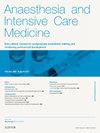Anaesthesia for patients with sickle cell disease and other haemoglobinopathies
IF 0.2
Q4 ANESTHESIOLOGY
引用次数: 0
Abstract
Sickle cell disease is an autosomal recessive multi-systemic blood condition, caused because of a mutation in chromosome 11 resulting in production of abnormal β globin of haemoglobin or HbS. The abnormality under specific conditions results in polymerization of the globin chain resulting in deformed sickle-shaped red cells. These haemolyse under adverse conditions resulting in occlusion within the circulatory system resulting in cardio-respiratory, neurological, renal, musculoskeletal and bone marrow dysfunction, along with increased susceptibility to infections leading to significant morbidity and mortality. The perioperative period provides the perfect milieu for exacerbations. Careful planning and preparation with haematology input, good oxygenation, multi-modal analgesia, hydration, antibiotic prophylaxis, and maintenance of normothermia are the key preventative strategies utilized in this setting. Hydroxyurea, voxelotor, blood transfusion and haematopoietic bone marrow transplant are the available options for treatment. L-glutamine is not currently used in clinical practice in UK.
求助全文
约1分钟内获得全文
求助全文
来源期刊

Anaesthesia and Intensive Care Medicine
ANESTHESIOLOGY-
CiteScore
0.50
自引率
0.00%
发文量
152
期刊介绍:
Anaesthesia and Intensive Care Medicine, an invaluable source of up-to-date information, with the curriculum of both the Primary and Final FRCA examinations covered over a three-year cycle. Published monthly this ever-updating text book will be an invaluable source for both trainee and experienced anaesthetists. The enthusiastic editorial board, under the guidance of two eminent and experienced series editors, ensures Anaesthesia and Intensive Care Medicine covers all the key topics in a comprehensive and authoritative manner. Articles now include learning objectives and eash issue features MCQs, facilitating self-directed learning and enabling readers at all levels to test their knowledge. Each issue is divided between basic scientific and clinical sections. The basic science articles include anatomy, physiology, pharmacology, physics and clinical measurement, while the clinical sections cover anaesthetic agents and techniques, assessment and perioperative management. Further sections cover audit, trials, statistics, ethical and legal medicine, and the management of acute and chronic pain.
 求助内容:
求助内容: 应助结果提醒方式:
应助结果提醒方式:


